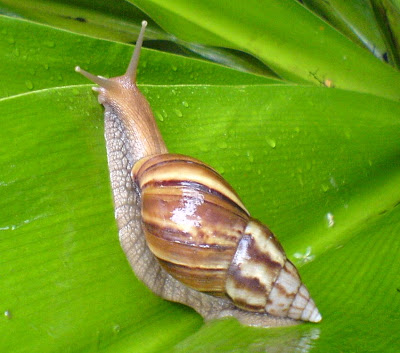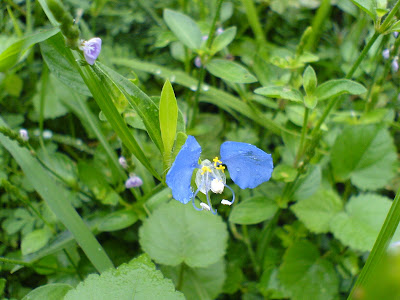Its been an interesting fortnight.
# Went on tree walks with toddlers and teenagers.
# Rambled at the PWD park, with the sun, bees and butterflies for company.
# Saw pictures from Chandrika of a creature that looked like it had come from some alien land.
# Learnt that cycle tires can make good and cheap tree-guards.
# Discovered an argiope inside one of those tree guards.
# Saw scores of black kites all of a sudden.
# Have been tracking an ugly little "crowling" grow into a handsome large-billed crow, all set to fly.

The tree walks and the PWD park ramble were courtesy
Nizhal, that wonderful, enthusiastic band of tree lovers of Chennai. Their volunteers go around, in different localities and parks of the city, with different groups, taking young and old on walks to familiarise us with the trees of the neighbourhood, and hoping to spread awareness and commitment for saving our trees.
May their tribe grow.
One of the projects which is currently consuming their time, energy and attention is the PWD land/park in Kotturpuram on the southern bank of the Adyar river. Local species are being planted in order to make a tree park - no lawns or concrete walkways, is what I've understood it.
It was here that a bunch of toddlers came, to plant a few saplings and get sensitised about the need for trees.
The planting was done with much enthusiasm, as also the chasing of butterflies and mynahs. The high point was finding an earthworm in the soil as they planted, and there was many a "ewww" from the girls, while the boys fell strangely silent, taking a tentative step backwards, as Deepika extended her earthworm-filled hand to display it better!
It was here that I learnt that discarded tires make cheap and quick tree guards.

Nizhal volunteers come on Sundays, and quickly put these together, through some clever entwining of binding tape. There had been a couple of showers and so the ground was covered with green undergrowth, and I quite enjoyed hanging out there, never mind the sun.
So it was that I volunteered to go and check on the saplings one Tuesday morning - the saplings do need to be tended - and made an interesting "discovery. More about that later.
The case of the Bagworm moth
On returning home, I found a strange email in my inbox, titled "strange flower feeder". Chandrika of MNS posted these pictures:
I had obviously under-estimated the "pros" of MNS. Quick came the replies - thats a bagworm moth larva, dear, go look it up! And so I did. It turns out that larvae of this moth family build their cases out of any old debris they find around - twigs, soil, leaves - as soon as they hatch. The binding is a kind of silk they secrete.
Now, as it grows, it carries this case and moves along, and the caterpillar pokes it heads out to feed on the leaves of the host plant, like any hungry caterpillar. When it is fully grown, it anchors the case to a branch and seals the opening. It then develops into a moth. If its a male, its lucky, it grows wings supposedly and then flies off to find a mate.
But if you are born a female bagworm moth, then life cannot be much fun - you are stuck in that case, you lay your eggs in it and then you die!
If that was not interesting enough, my next visit to the PWD park revealed yet another mystery.
St Andrew's Cross
It had rained insistently for a couple of days, and so the park looked even greener. The undergrowth was wet, the little meadow flowers were buzzing with bees, and as the sun was up already, the butterflies were going crazy chasing each other.
My visit was supposedly to take a look at all the saplings and report back on their state. So I dutifully, stuck my head into every tree guard, to make sure the sapling was alive and well.
And I was rewarded with this!

I stopped short and stared. I have never seen such a large and complete web in my life. I swear, it was atleast 2ft by 2ft.

Hmmm, but it seemed to have only four legs, and as far as I knew all self-respecting spiders have eight.
Not four legs, but eight, held together in an "x" cross. And so the reference to St Andrew who was crucified on a cross like this and not the standard crucifying cross.
Here's some more interesting stuff about Argiope:
Besides their standard orb-web, Argiope spiders build additional white opaque zig zag lines on their webs, called stabilimentum.
Sometimes the zig-zag lines match their leg positions, which lead some people to suggest that this helps give the appearance of longer legs. Some spiders build a single vertical line, yet others a patch of zig zags in the centre of the web. No matter the design, the spider sits right smack in the middle. We do not know the purpose of these lines, but some of the explanations put forward include:
They stabilise the web (hence their name!)
They warn larger animals in the same way that safety strips on glass doors warn people from walking into them. Thus the web is protected from damage by flying birds.
Research has shown that the silk in the stabilimentum reflects ultraviolet well, unlike the silk used in the rest of the web. Thus, the designs may mimic flowers, which also reflect ultraviolet light well, and often have lines to guide insects to honey like airport lights do for airplanes. Instead, the insects are guided to the spider which sits in the centre!!
Source: The Mangrove and Wildlife at Sungei Buloh Wetlands Reserve.And I had thought that stabilimentum was the twining tape!! According to this website, Argiope mangal puts out two stabilimentum, and Argiope versicolor puts out four. This one has three!
And guess what. I could not find this chappie there. (Actually, its a lady - only lady spiders build webs...So what do the male ones do for food? I need to find out.)
I cannot find any India mentions of this spider. So, is my id wrong then? or is this some stray imported spider which shouldn't be here?
Somebody help!
 The Madras Club cupola above the grand trees, on the opposite bank of the estuary.
The Madras Club cupola above the grand trees, on the opposite bank of the estuary.
Look under those leaves and rocks, folks, you never know what you will find!
 I quite like the design of the entrance, though the gate could have been wider?
I quite like the design of the entrance, though the gate could have been wider?
 Terminalia arjuna. I have not seen such a magnificent specimen.
Terminalia arjuna. I have not seen such a magnificent specimen.
 Strychnos nux-vomica. Loved by Agatha Christie and ayurveda!
Strychnos nux-vomica. Loved by Agatha Christie and ayurveda!
 Erythrina indica and the diamond shaped leaves of the kalyan murungai
Erythrina indica and the diamond shaped leaves of the kalyan murungai
 The light fades as we reach the Brazilian Ironwood
The light fades as we reach the Brazilian Ironwood


 Nanmangalam reserve forest - the landmark hill within
Nanmangalam reserve forest - the landmark hill within  The quarry - filled with rain water, but look at the floating thermocol
The quarry - filled with rain water, but look at the floating thermocol Clcik on the pcture, and you will see that the white floating substance at the far end on the water is more thermocol
Clcik on the pcture, and you will see that the white floating substance at the far end on the water is more thermocol The bags of garbage we cleared in one hour...there is much more.
The bags of garbage we cleared in one hour...there is much more. Terminalia arjuna - fruiting
Terminalia arjuna - fruiting Morinda citrifolia-Nuna
Morinda citrifolia-Nuna

 The huge snail that caught all the oohs and aahs
The huge snail that caught all the oohs and aahs Commelina - day flowers
Commelina - day flowers Tree unknown
Tree unknown Plumeria obtusa - Singapore frangipani
Plumeria obtusa - Singapore frangipani





 An ant trying to get at the larvae
An ant trying to get at the larvae
 See the head poking out
See the head poking out



 The Madras Club cupola above the grand trees, on the opposite bank of the estuary.
The Madras Club cupola above the grand trees, on the opposite bank of the estuary.
